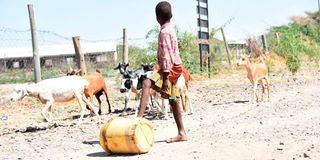Drought kept more than 2 million children out of school, report says

A gilrl pushes a jerrican of water at Lowareng’ak village in Turkana County on October 12, 2022 amid a biting drought.
More than two million children did not attend their third term classes due to the ongoing drought in the country, a study has shown.
The study, commissioned by international non-governmental organisation Save the Children, also reveals that over 3.5 million will not report back come January 2023 when schools reopen as the hunger crisis worsens.
The Global Out of School Children Initiative report, that was released early this week, reported that an additional 1.6 million children aged between four and 17 are at a high risk of dropping out schools reopen for the first term next year.
About 17 counties are affected and this has significantly decreased enrolment, with an average of 52 per cent learning institutions affected across all levels, including early childhood education and development, primary and secondary.
Mandera, Garissa, Wajir, Turkana and Marsabit are amongst the worst affected counties.
Mandera County has the highest number of school dropouts — 295,470 children — followed by Garissa with 289,410 then Wajir (266,540), Turkana (253,640) and Marsabit (107,600). Others are Narok (83,020), West Pokot (80,070) and Samburu (64,818).
According to the September 2022 risk report published by the National Drought Management Authority (NDMA), about 4.3 million people are in need of emergency food assistance.
The NDMA report states that over 942,000 cases of malnutrition have been reported in children aged between six and 59 months, while 134,000 cases of pregnant and lactating women are acutely malnourished and in need of treatment.
In Turkana County alone, more than 800,000 people are suffering from acute malnutrition, specifically wasting.
In Mandera County, at least 100 children are malnourished.
The main reason for the drought is the four consecutive seasons of failed or poorly distributed rains. The study highlighted the shortage of water in schools, lack of school meals, lack of teachers, dilapidated infrastructure and resource-based conflicts as reasons for learners dropping out. An analysis of water in primary and secondary schools in the 17 counties revealed that 460 learning institutions do not have any water source whatsoever while1,896 schools only rely on harvested rainwater.
“Kenya is experiencing one of the worst droughts in 40 years. Children are the most vulnerable groups and are usually the most affected in such emergencies,” said Ms Yvonne Arunga, the Save the Children Country Director in charge of Kenya and Madagascar.
“Parents have to migrate with their children in search of food, pasture and water for their livestock. This compromises their access to basic facilities such as food, clean water, healthcare and education,” she said.
Northern Kenya, a predominantly pastoralist community, parents are unable to pay school fees because they have lost their livestock. Communities are focused on basic survival and school-going children have to help their parents take care of livestock and carry out domestic chores.
To address these gaps in education, Save the Children is implementing the Operation Come to School Project — christened “Watoto Rudi Shule” — in a bid to increase the enrolment and retention of children who are out of school in Wajir Turkana, Baringo and Bungoma Counties.
The organisation, together with other partners, provide lifesaving assistance to children and their families through different programmes, including water hygiene and sanitation and education interventions.
They have reached 737,931 people including 405,511 children this year through the initiative.





